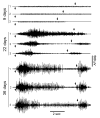Neurophysiological characterization of motor recovery in acute spinal cord injury
- PMID: 21079622
- PMCID: PMC3444805
- DOI: 10.1038/sc.2010.145
Neurophysiological characterization of motor recovery in acute spinal cord injury
Abstract
Study design: Prospective cohort study.
Objective: This study was designed to neurophysiologically characterize motor control recovery after spinal cord injury (SCI).
Setting: University of Louisville, Louisville, Kentucky, USA.
Material: Eleven acute SCI admissions and five non-injured subjects were recruited for this study.
Methods: The American Spinal Injury Association Impairment Scale (AIS) was used to categorize injury level and severity at onset. Multimuscle surface electromyography (sEMG) recording protocol of reflex and volitional motor tasks was initially performed between the day of injury and 11 days post onset (6.4±3.6, mean±s.d. days). Follow-up data were recorded for up to 17 months after injury. Initial AIS distribution was as follows: 4 AIS-A; 2 AIS-C; 5 AIS-D. Multimuscle activation patterns were quantified from the sEMG amplitudes of selected muscles using a vector-based calculation that produces separate values for the magnitude and similarity of SCI test-subject patterns to those of non-injured subjects for each task.
Results: In SCI subjects, overall sEMG amplitudes were lower after SCI. Prime mover muscle voluntary recruitment was slower and multimuscle patterns were disrupted by SCI. Recovery occurred in 9 of the 11 subjects, showing an increase in sEMG amplitudes, more rapid prime mover muscle recruitment rates and the progressive normalization of the multimuscle activation patterns. The rate of increase was highly individualized, differing over time by limb and proximal or distal joint within each subject and across the SCI group.
Conclusions: Recovery of voluntary motor function can be quantitatively tracked using neurophysiological methods in the domains of time and multimuscle motor unit activation.
Figures




Similar articles
-
Long-lasting involuntary motor activity after spinal cord injury.Spinal Cord. 2011 Jan;49(1):87-93. doi: 10.1038/sc.2010.73. Epub 2010 Jun 29. Spinal Cord. 2011. PMID: 20585326 Free PMC article.
-
Patterns of Sacral Sparing Components on Neurologic Recovery in Newly Injured Persons With Traumatic Spinal Cord Injury.Arch Phys Med Rehabil. 2016 Oct;97(10):1647-55. doi: 10.1016/j.apmr.2016.02.012. Epub 2016 Mar 10. Arch Phys Med Rehabil. 2016. PMID: 26971670
-
Brain Motor Control Assessment Post Early Intensive Hand Rehabilitation After Spinal Cord Injury.Top Spinal Cord Inj Rehabil. 2018 Spring;24(2):157-166. doi: 10.1310/sci17-00008. Epub 2017 Nov 17. Top Spinal Cord Inj Rehabil. 2018. PMID: 29706760 Free PMC article. Clinical Trial.
-
Guidelines for the conduct of clinical trials for spinal cord injury as developed by the ICCP panel: spontaneous recovery after spinal cord injury and statistical power needed for therapeutic clinical trials.Spinal Cord. 2007 Mar;45(3):190-205. doi: 10.1038/sj.sc.3102007. Epub 2006 Dec 19. Spinal Cord. 2007. PMID: 17179973 Review.
-
Characterizing Natural Recovery after Traumatic Spinal Cord Injury.J Neurotrauma. 2021 May 1;38(9):1267-1284. doi: 10.1089/neu.2020.7473. Epub 2021 Jan 22. J Neurotrauma. 2021. PMID: 33339474 Free PMC article. Review.
Cited by
-
Evidence for reticulospinal plasticity underlying motor recovery in Brown-Séquard-plus Syndrome: a case report.Front Neurol. 2024 Jun 4;15:1335795. doi: 10.3389/fneur.2024.1335795. eCollection 2024. Front Neurol. 2024. PMID: 38895696 Free PMC article.
-
Muscle Activation Patterns During Movement Attempts in Children With Acquired Spinal Cord Injury: Neurophysiological Assessment of Residual Motor Function Below the Level of Lesion.Front Neurol. 2019 Dec 20;10:1295. doi: 10.3389/fneur.2019.01295. eCollection 2019. Front Neurol. 2019. PMID: 31920919 Free PMC article.
-
Model of Traumatic Spinal Cord Injury for Evaluating Pharmacologic Treatments in Cynomolgus Macaques (Macaca fasicularis).Comp Med. 2018 Feb 1;68(1):63-73. Comp Med. 2018. PMID: 29460723 Free PMC article.
-
Neurophysiological Changes in the First Year After Cell Transplantation in Sub-acute Complete Paraplegia.Front Neurol. 2021 Jan 18;11:514181. doi: 10.3389/fneur.2020.514181. eCollection 2020. Front Neurol. 2021. PMID: 33536992 Free PMC article.
-
Properties of the surface electromyogram following traumatic spinal cord injury: a scoping review.J Neuroeng Rehabil. 2021 Jun 29;18(1):105. doi: 10.1186/s12984-021-00888-2. J Neuroeng Rehabil. 2021. PMID: 34187509 Free PMC article.
References
-
- Yilmaz F, Sahin F, Aktug S, Kuran B, Yilmaz A. Long-Term Follow-up of Patients with Spinal Cord Injury. Neurorehabil Neural Repair. 2005;19(4):332–7. - PubMed
-
- Illis LS. The motor neuron surface and spinal shock. In: Williams Denis., editor. Modern Trends in Neurology. 0. Vol. 4. Vol. 4. Appleton-Century-Crofts; 1967. pp. 53–68. - PubMed
-
- Kakulas BA. Neuropathology: the foundation for new treatments in spinal cord injury (Sir Ludwig Guttman Lecture) Spinal Cord. 2004;42:549–563. - PubMed
-
- Marino RJ, Barros T, Biering-Sorensen F, Burns SP, Donovan WH, Graves DE, Haak M, Hudson LM, Priebe MM ASIA Neurological Standards Committee. International standards for neurological classification of spinal cord injury. J Spinal Cord Med. 2003;26 (Suppl 1):S50–6. - PubMed
Publication types
MeSH terms
Grants and funding
LinkOut - more resources
Full Text Sources
Medical

